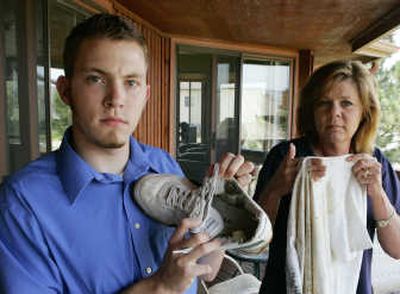iPods conduct more than sound

Listen to an iPod during a storm and you may get more than electrifying tunes.
A Canadian jogger suffered wishbone-shaped chest and neck burns, ruptured eardrums and a broken jaw when lightning traveled through his music player’s wires.
Last summer, a Colorado teen ended up with similar injuries when lightning struck nearby as he was listening to his iPod while mowing the lawn.
Emergency physicians report treating other patients with burns from accidents while using personal electronic devices such as beepers, Walkman players and laptop computers outdoors during storms.
Michael Utley, a former stockbroker from West Yarmouth, Mass., who survived being struck by lightning while golfing, has tracked 13 cases since 2004 of people hit while talking on cell phones. They are described on his Web site, www.struckbylightning.org.
Contrary to some urban legends and media reports, electronic devices don’t attract lightning the way a tall tree or a lightning rod does.
“It’s going to hit where it’s going to hit, but once it contacts metal, the metal conducts the electricity,” said Dr. Mary Ann Cooper, of the American College of Emergency Physicians and an emergency room doctor at University of Illinois Medical Center at Chicago.
When lightning jumps from a nearby object to a person, it often flashes over the skin. But metal in electronic devices – or metal jewelry or coins in a pocket – can cause contact burns and exacerbate the damage.
A spokeswoman for Apple Inc., the maker of iPods, declined to comment. Packaging for iPods and some other music players do include warnings against using them in the rain.
Lightning strikes can occur even if a storm is many miles away, so lightning safety experts have been pushing the slogan “When thunder roars, go indoors,” said Cooper.
Jason Bunch, 18, says it wasn’t even raining last July, but there was a storm off in the distance. Lightning struck a nearby tree, shot off and hit him.
“It was a real miracle” he survived, said his mother, Kelly Risheill.
The Canadian jogger suffered worse injuries, according to a report in today’s New England Journal of Medicine.
The man, a 39-year-old dentist from the Vancouver area, was listening to an iPod while jogging in a thunderstorm when, according to witnesses, lightning hit a tree a couple of feet away and jumped to his body. The strike threw the man about eight feet and caused second-degree burns on his chest and left leg.
The electric current left red burn lines running from where the iPod had been strapped to his chest up the sides of his neck. It ruptured both ear drums, dislocated tiny ear bones that transmit sound waves, and broke the man’s jaw in four places, said Dr. Eric Heffernan, an imaging specialist at Vancouver General Hospital.
The injury happened two summers ago. Despite treatment, the man still has less than 50 percent of normal hearing on each side, must wear hearing aids and can’t hear high-pitched sounds.
“He’s a part-time musician, so that’s kind of messed up his hobby as well,” Heffernan said.
Like the Colorado teen, the Canadian patient, who declined to be interviewed or identified, has no memory of the lightning strike.
In another case a few years ago, electric current from a lightning strike ran through a man’s pager, burning both him and his girlfriend who was leaning against him, said Dr. Vince Mosesso, an emergency doctor at University of Pittsburgh Medical Center.
Eardrum ruptures are considered the most common ear injury in lightning-strike victims, occurring in 5 percent to 50 percent of patients, according to various estimates, regardless of whether an electronic device is involved. A broken jaw is rare, doctors say.